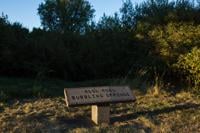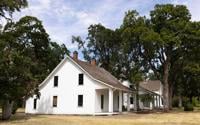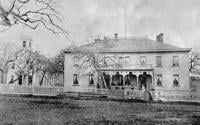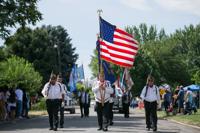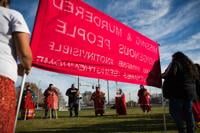Credits: This timeline was compiled by Carlos Pelley of Yakima Valley Libraries; Anna King, a correspondent with the Northwest News Network and Northwest Public Broadcasting; and editor Joanna Markell and reporter Tammy Ayer with the Yakima Herald-Republic.
Since Time Immemorial: Mool-Mool springs Indigenous village and crossroads site existed at what is now Fort Simcoe Historical State Park, according to Jon Shellenberger, an archaeologist and member of the Confederated Tribes and Bands of the Yakama Nation.
1805: Lewis and Clark visited the Columbia Basin, in present-day Pasco. According to HistoryLink.org, “Many tribes fished and wintered in the flats along the Columbia at the mouth of the Snake. The Lewis and Clark Expedition camped at the site in 1805 and 1806, and reported that Indians gathered there in great numbers.”

A sign for the Mool Mool springs at Fort Simcoe is seen Monday, Sept. 26, 2022, near White Swan, Wash.
1819: The Indian Civilization Act established Indian boarding schools across the nation. The goal was to culturally assimilate Indigenous children by forcibly relocating them from their families to distant residential facilities where their identities, languages and beliefs were forcibly suppressed, according to a U.S. Department of Interior report.
1824: Fort Vancouver was established as an important Hudson’s Bay Company fur trading post.
1855: The Yakama War started when non-Native miners on Indigenous land raped and murdered a mother, her teenage daughter and her baby. Yakama warriors, including the family’s father, responded by killing the miners and Agent Andrew J. Bolon after he threatened reprisals for the killings.

The staff officer quarters are pictured at Fort Simcoe State Park Friday, Aug. 4, 2023, near White Swan, Wash.
1856: Fort Simcoe was established. The U.S. Army arrived in the Yakama region in the summer of 1856. That August, Robert S. Garnett supervised the building of Fort Simcoe as a military post. Initially, the conflict was limited to the Yakama Tribes and Bands but then the Walla Walla and Cayuse Tribes were drawn into the war as well.
1858: The Yakama War ended at the Battle of Four Lakes near Spokane in September. Col. George Wright inflicted a conclusive loss on the Native Americans. He called a council of all the local Native Americans at Latah Creek, southwest of Spokane. He imposed a peace treaty, under which most tribal members were to go to reservations.
1858: About 800 Yakama horses were slaughtered by the U.S. Army at what is known as Horse Slaughter Camp, in the Spokane area, to end any possibility of the Yakama forming a cavalry.

The girls dormitory at Fort Simcoe is pictured in 1906 near White Swan, Wash.
1860: Fort Simcoe Indian Boarding School near White Swan was established in the fall under the Yakama Indian Agency, part of the Bureau of Indian Affairs. James Wilbur, a Methodist preacher and teacher, opened the boarding school for Indigenous children at Fort Simcoe. The school was open nine months a year. There were 18 students in the first class — 16 boys and two girls. This school is older than the infamous Carlisle Indian Industrial School in Pennsylvania. There are 15 known boarding schools in Washington and nine in Oregon.
1861: White settlement of the Yakima Valley began. The Thorp family settled near Ahtanum.
1877: Yakama Chief Kamiakin died at his home in Rock Lake, Wash. He never lived on the Yakama reservation. His grave was defiled when grave robbers stole his skull. The Yakama people then moved his remains to a secret location.
1879: Following the Bannock War, U.S. General Howard received orders to move about 540 Paiute and Bannock prisoners from the Malheur Indian Reservation to the Yakama Indian Reservation, in Washington Territory, 350 miles to the north.
1885: Rail routes were established in the Yakima Valley.

Dormitory demolition at Fort Simcoe near White Swan, Wash., February 20, 1955.
1889: Washington became a state.
1898-99: In the winter, several epidemics sickened children and others at Fort Simcoe; five students died.
1919: Fire destroyed the Fort Simcoe classroom building in December.
1920: Fort Simcoe boarding school closed.
1922: The Bureau of Indian Affairs moved from Fort Simcoe to a Toppenish location, which later became the Toppenish library.
1924: Native Americans were recognized as citizens of the U.S.

Yakama Warriors march in the Toppenish Wild West Parade Saturday, July 6, 2019, in downtown Toppenish, Wash.
1933: The Yakama were organized as the Confederated Tribes and Bands of the Yakama Nation. According to the Columbia River Inter-Tribal Fish Commission webpage: “The bands and tribes in the Yakama confederation are the Kah-milt-pah, Klickitat, Klinquit, Kow-was-say-ee, Li-ay-was, Oche-chotes, Palouse, Pisquose, Se-ap-cat, Shyiks, Skinpah, Wenatshapam, Wishram, and Yakama. Today, representatives of each of those bands and tribes make up the Yakama Tribal Council.”
1920-1945: Yakama citizens fought in World Wars I and II. According to the Gilder Lehrman Institute of American History, more than 11,000 American Indians served with the American forces during World War I. Of those men, approximately 6,500 were drafted — despite the fact that almost half of Native Americans were not citizens and therefore not eligible for conscription.
In WWII, of the 350,000 Native Americans living in the country at the time, nearly 45,000 of them enlisted in the Armed Forces, making them the demographic with the highest rate of voluntary enlistment in the military throughout the entire war.
1944: In recognition of the original 14 treaty signers, a tribal council of 14 leaders was formally established by the General Membership Council and authorized to transact business for the Yakama Nation, according to the Yakama Nation History Museum.
1956: The Yakama granted Washington State Parks use of Fort Simcoe in a 99-year lease for preservation as a historic monument.
1974: In the Boldt Decision, the federal government reaffirmed Yakama fishing rights and made the tribes a co-manager of fishery resources with the state of Washington.
2017: The first national day of awareness for missing and murdered Native women and girls takes place.

People gather outside the Yakama Legends Casino Events Center in Toppenish, Wash. before the first meeting of the state’s new task force for missing and murdered Indigenous people on Thursday, Dec. 2, 2021.
2018 and ’19: The Yakama Nation Victim Resource Program REDgalia campaign and others held a rally and walk in Toppenish.
2019: Operation Lady Justice was launched by the Presidential Task Force on Missing and Murdered American Indians and Alaska Natives to focus the criminal justice system on missing and murdered people.
2021: Secretary of the Interior Deb Haaland launched the Federal Indian Boarding School Initiative, an effort to recognize the history and legacy of federal Indian boarding school policies.
2021: The Washington State Missing and Murdered Indigenous Task Force had its first meeting in Toppenish.
2022: Atrocities at boarding schools were first acknowledged by the federal government in a Department of Interior report.
This post was originally published on this site be sure to check out more of their content.



